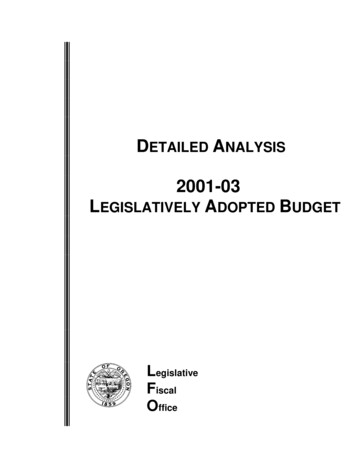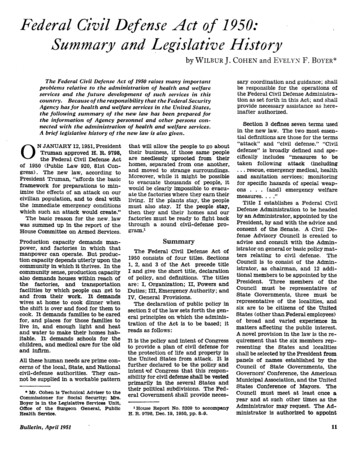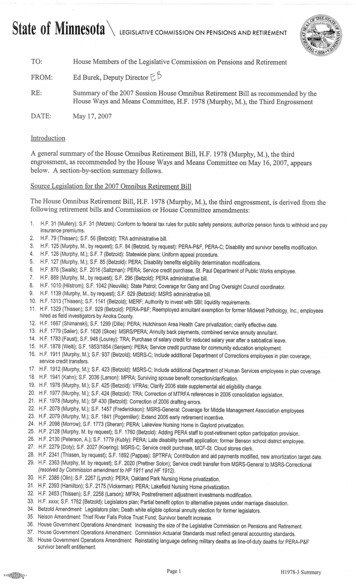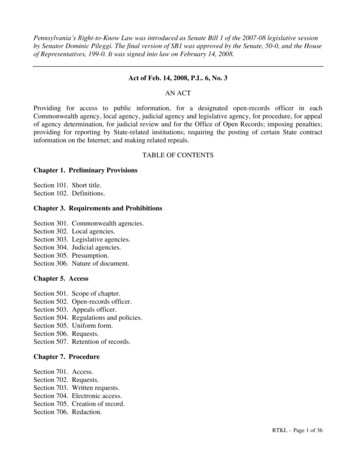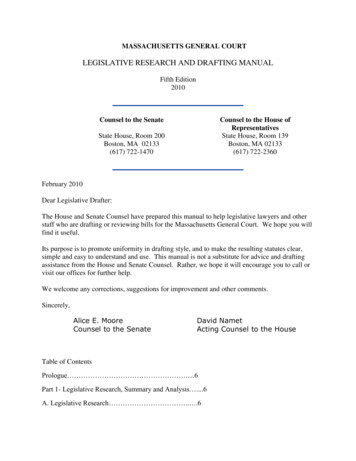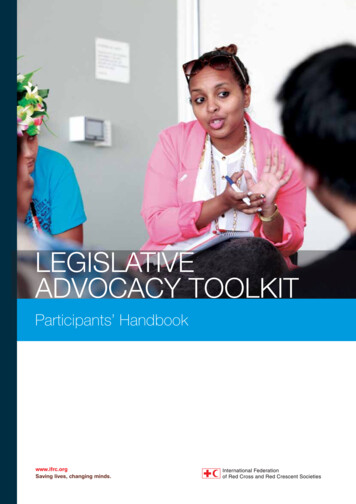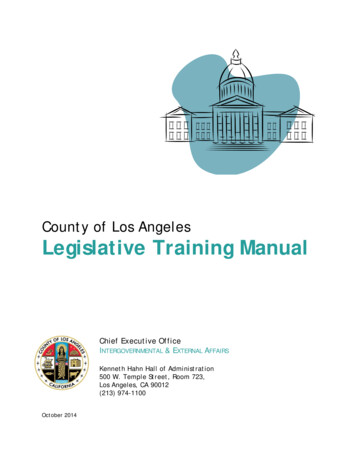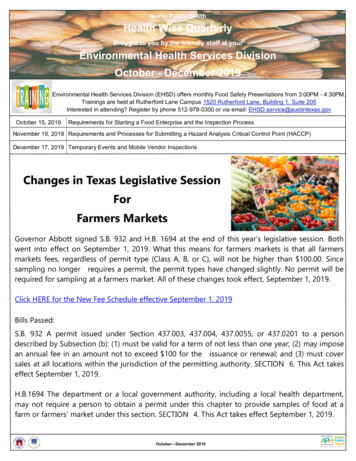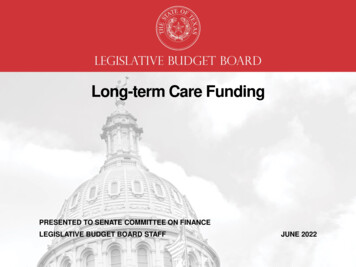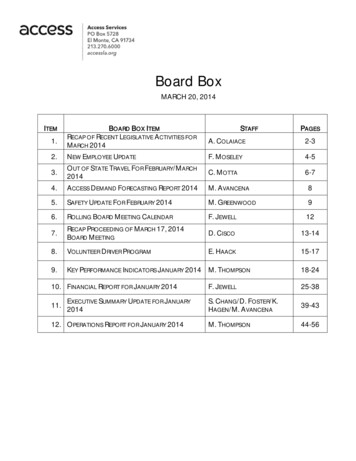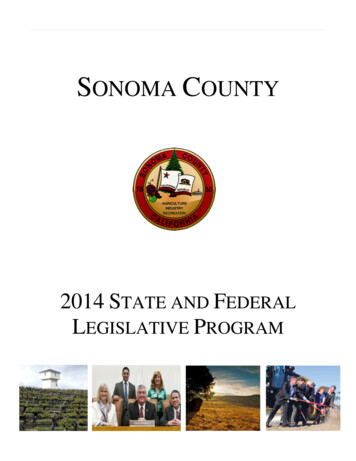
Transcription
Page -0-SONOMA COUNTY2014 STATE AND FEDERALLEGISLATIVE PROGRAM
SONOMA COUNTYBOARD OF SUPERVISORSSusan Gorin . District 1David Rabbitt. District 2Shirlee Zane . District 3Mike McGuire . District 4Efren Carrillo . District 5Veronica A. Ferguson . County Administrator-1-
County StaffPeter Rumble, Deputy County Administrator–Community and Government AffairsCounty of Sonoma575 Administration Drive, Suite 104ASanta Rosa, CA 95403(707) 565-3771peter.rumble@sonoma-county.orgRebecca Wachsberg, CAO AnalystCounty of Sonoma575 Administration Drive, Suite 104ASanta Rosa, CA 95403(707) 565-3782rebecca.wachsberg@sonoma-county.orgState AdvocatesPeterson Consulting, Inc. – Shaw / Yoder / Antwih, Inc.1415 L Street, Suite 1000Sacramento, CA 95814(916) 441-4424Petersonconsulting@earthlink.netFederal AdvocatesAlcalde & Fay2111 Wilson Boulevard, 8th FloorArlington, VA 22201(703) 841-0626Schlesinger@Alcalde-Fay.comMadison Government Affairs, Inc.444 North Capitol Street, NWWashington, DC 20001(202) 347-1223jack@madisongov.net-2-
Sonoma County Legislative State DelegationsGovernor Jerry Brown (D)Governor of CaliforniaState Capitol BuildingSacramento, CA 95814Email: www.govmail.ca.govWebsite: www.gov.ca.govWashington D.C. Office124 Hall of the States444 North Capitol Street NWWashington, D.C. 20001Phone: (916) 445-2841Fax: (916) 445-4633Phone: (202) 624-5270Fax: (202) 624-5280State RepresentativesState SenateSenator Noreen Evans (D)State Senate District 250 D St., #120ASanta Rosa, CA 95404Email: ed.sheffield@sen.ca.govWebsite: www.dist02.casen.govoffice.comState Capitol, Room 4032Sacramento, CA 95814Phone: (707) 576-2771Fax: (707) 576-2773Phone: (916) 651-4002Fax: (916) 323-6958Senator Lois Wolk (D)State Senate District 3555 Mason Street, Suite 230Vacaville, CA 95688Email: senator.wolk@senate.ca.govWebsite: www.dist03.casen.govoffice.comState Capitol, Room 5114Sacramento, CA 95814Phone: (707) 454-3808Fax: (707) 454-3811Phone: (916) 651-4003Fax: (916) 323-2304State AssemblyAssemblyman Wes Chesbro (D)2nd Assembly District50 D Street, Suite 450Santa Rosa, CA 95404Email:maddy.hirshfield@asm.ca.govWebsite: www.asmdc.org/members/a02/P.O. Box 942849Sacramento, CA 94249-0001Phone: (707) 576-2526Fax: (707) 576-9031Phone: (916) 319-2001Fax: (916) 319-2101Assemblyman Marc Levine (D)10th Assembly District3501 Civic Center Drive, Suite 412San Rafael, CA 94903Email: Michael.miller@asm.ca.govWebsite: www.asmdc.org/members/a10/P.O. Box 942849-0010Sacramento, CA 94249-0006Phone: (415) 479-4920Fax: (415) 479-2123Phone: (916) 319-2010Fax: (916) 319-2110-3-
Assemblywoman Mariko Yamada4th District555 Mason Street, Suite 275Vacaville, CA 95688Email: yamada@asm.ca.govWebsite: www.assembly.ca.gov/State CapitolP.O. Box 942849Sacramento, CA 94249-0007Phone: (707) 455-8025Fax: (707) 455-0490Phone: (916) 319-2004Fax: (916) 319-2104Federal RepresentativesUnited States SenateSenator Barbara Boxer (D)United States Senate1700 Montgomery Street, Suite 240San Francisco, CA 94111Email: Senator@boxer.senate.govWebsite: www.boxer.senate.gov112 Hart Senate Office BuildingWashington, D.C. 20510Phone: (415) 393-0707Fax: (202) 224-0454Phone: (202) 224-3553Fax: (202) 224-0454Senator Dianne Feinstein (D)United States SenateOne Post Street, Suite 2450San Francisco, CA 94104Email: Senator@feinstein.senate.govWebsite: www.feinsteinein.senate.gov331 Hart Senate Office BuildingWashington, D.C. 20510Phone: (415) 393-0707Fax: (415) 393-0710Phone: (202) 228-3954Fax: (202) 228-3954United States House of RepresentativesCongressman Jared Huffman (D)California’s 2nd Congressional District206 G Street, Unit #3Petaluma, CA 94952Email: kelly.meeker@mail.house.govWebsite: www.huffman.house.gov/1630 Longworth HOBWashington, D.C. 20515-0501Phone: (202) 225-5161Fax: (202) 225-5163Phone: (202) 225-5161Fax: (202) 225-5163Congressman Mike Thompson (D)California’s 5th Congressional District2300 County Center DriveSanta Rosa, CA 95403Email: Cheryl.diehm@mail.house.govWebsite: www.mikethompson.house.gov/231 Cannon HOBWashington, DC 20515-0501Phone: (707) 226-9898Fax: (707) 251-9800Phone: (202) 225-3311Fax: (202) 225-4335-4-
Sonoma County 2014 Legislative ProgramTable of ContentsPage No.Introduction and Guiding Principles .6Top State Priorities. 8Top Federal Priorities. 13General State and Federal Issues . 18Health and Human Services . 18Natural Resources . 24Criminal Justice. 32Development, Administrative Support & Fiscal Services . 34County Supported Items with Other Lead Agencies . 40Appendix A – Combined Federal Advocacy Issues . 46-5-
Introduction and Guiding PrinciplesIntroductionThe ability of the County to serve the residents of Sonoma County and provide for a thriving and sustainablecommunity requires support from all levels of government. Local government is uniquely and best positioned tosupport, serve, and respond to community and individual needs. However, State and Federal legislative policy andaction is often needed to support local government in having this impact. State and Federal action can affect theCounty’s ability to deliver services, shape what services the County delivers, impact the resources available forservices, and remove obstacles to delivering services.In order to fulfill Sonoma County’s commitment to the community, positive State and Federal action includingthe allocation of resources should be sought. Sonoma County has engaged with legislative advocates at the Stateand Federal level, resulting in the accomplishment of legislative priorities and positioning Sonoma County toreceive significant financial resources.To this end, Sonoma County adopts an annual legislative platform that provides a guide for Sonoma County’slegislative advocates, and highlights key issues important to the local community. The platform provides 10 overarching guiding principles, prioritizes State and Federal issues intended for specific legislative action, and lays outongoing general State and Federal issues that the County will monitor for potential action should opportunitiesarise.Guiding PrinciplesThrough this platform, Sonoma County will use advocates, professional associations (such as the California StateAssociation of Counties and the National Association of Counties), local elected officials and staff to:1. Seek out, develop, and support legislative and budget efforts that protect and/or enhance local governments’revenues, maximize the County’s access to state and federal funding sources, and/or increases local fundingflexibility.2. Oppose any effort to balance the state budget through the taking of local government resources, and supportlegislation that will allow the County to ensure full cost recovery for services provided to other governmentalentities.3. Support legislation that furthers the goals identified in the County’s Strategic Plan: Safe, Healthy and CaringCommunities; Economic and Environmental Stewardship; Invest in the Future; and Civic Services andEngagement.4. Encourage and seek legislation to facilitate orderly and sustainable economic development, and increase theopportunity for discretionary revenues, and programmatic and financial flexibility for the County.5. Oppose unfunded mandates, and oppose any realignment initiatives which fail to fully fund services shifted tothe County, including appropriate cost of living increases and cost increases due to population and caseloadgrowth.6. Support the County’s authority to assure mutually acceptable tax sharing agreements for annexation andincorporation that protect or enhance the County’s ability to provide services to its residents.7. Support legislation that provides tax, bond and other funding formulas for the equitable distribution of stateand federal monies while opposing attempts to decrease, restrict, or eliminate County revenue sources.-6-
8. Support legislation and budget action that provides additional and continuing funding for local roadinfrastructure.9. Support legislation that encourages mutually respectful relationships between tribal and local governmentsincluding reform to both the fee-to-trust process and off-reservation gaming provisions to insure that theimpacts of tribal development are fully mitigated and jurisdictional issues are resolved.10. Support state and federal action advancing the health, vibrancy and resiliency of local communities throughevidence-based preventative services and efforts, and consistent with the National Prevention Strategy,including prevention of community violence and chronic disease; increasing access to care, services, andhousing; investment in safe and complete streets, parks and infrastructure; emphasizing education and earlychildhood development; and engaging the public.-7-
Sonoma County 2014 Legislative ProgramThe following are Sonoma County’s priority State and Federal advocacy issues for the 2014 State LegislativeSession. The numbering of items and order are for tracking purposes and do not denote rank or relativeimportance. For the Top Federal Priorities, where appropriate, issue areas have identified federal resources theCounty is actively seeking. A total of 98,020,000 to 104,020,000 is currently identified, and provided in summaryform as Appendix A.Top State Priorities1. Gun and Replica Weapon RegulationSonoma County has long supported the view that preventing gun and community violence is critical to its goal toachieve a thriving and healthy community. Related to this, the use of lethal force against persons carrying replicaweapons, such as copycat BB guns, is a significant threat to public safety and health. Often marketed as looking“just like the real thing”, these replica weapons can easily be used in crimes as tools of intimidation as well as bea significant contributing factor in officer-involved shootings.Sonoma County recently experienced a tragic officer-involved shooting, causing the death of a local 13 year-oldboy, Andy Lopez. This shooting is not an isolated incident; the problem includes recent shootings in Modesto bya Stanislaus County Sheriff’s deputy, and in San Diego and Los Angeles by city police officers. These shootingsare tragedies for all involved, and local police chiefs, county sheriffs, local elected officials, and communityleaders have repeatedly called for action to help reduce violence and harm arising from replica weapons.Actions: Support the expansion of sensible gun safety legislation, as well as legislation that will help preventreplica weapon tragedies, such as SB 1315 (De Leon), which provides a State Exemption and claims jurisdictionto enact local regulations related to replica weapons; and other legislative efforts that will help prevent replicaweapons triggering violence or being used to perpetrate violence.2. Sonoma Developmental CenterSonoma Developmental Center (SDC) is the oldest facility in California established specifically for serving theneeds of individuals with developmental disabilities. The facility opened its doors to 148 residents in 1891. Sincethat time, SDC has served as a critical resource to people in Sonoma County as well as throughout the North BayRegion. Today, SDC provides an extensive array of services that promote ongoing health, learning, self-advocacyand increased independence; and innovative social, recreational, educational, vocational, and other programs arecontinuously offered. Not only does SDC provide valuable services to individuals and families, it also serves as asignificant scenic and environmental resource; SDC is adjacent to natural open space and park land, along withheavily traveled wildlife trails. Ensuring the land continues to provide these community benefits is of greatimportance to the Board of Supervisors and the community.Actions: The County supports working with State and community stakeholders to find and develop legislation,funding, and other opportunities to preserve SDC’s valuable health services for Sonoma County and North Bayresidents as well as preserving critical environmental resources.3. Pension ReformThe Public Employee Pension Reform Act of 2012 (PEPRA) made significant changes to pension law for PERScontracting agencies as well as 1937 Act Counties. Sonoma County supports pension reform efforts, but isopposed to reforms that are inconsistent with principles adopted by the California State Association of Counties(CSAC). Concerns include loss of local control, lack of recognition for those programs that are fiscally andmanagerially sound, and loss of flexibility and employee choice of retirement age. Additionally, PEPRA remainsambiguous in many areas and requires further clarification.-8-
Action: The County supports legislation to further clarify PEPRA. Clean-up legislation should address, forexample, unintended benefit enhancements through industrial disability claims; the ability to share the costs dueto market investment losses and actuarial assumption changes equally with employees; and the authority for theBoard of Supervisors to appoint four additional public members to the Sonoma County Employees RetirementBoard.4. Jail Alternative Model RecognitionThe Legislature passed and the Governor signed SB 1022 as part of the 2012-13 budget. This legislation providesfunding for jail beds that are accompanied by programming facilities to improve outcomes for released prisoners.The Sonoma County Strategic Plan, adopted by the Board of Supervisors in December 2007 and re-affirmed bythe Board in October 2009 and November 2010, discusses the need to “more effectively address public safetyissues at the lowest risk levels for all members of the community, including early detection, intervention, anddiversion of minor criminal activity, substance abuse, and mental health issues.”Sonoma County is exploring a number of jail alternatives including the potential development of a CommunityCorrections Center. This model holds offenders accountable while providing programs to help them becomeproductive members of our community, and assists offenders in taking responsibility for their lives through lawabiding and responsible behavior. The model includes offering programs and services such as job skills training,life skills classes, thought-restructuring programs, individual and group counseling, alcohol and drug counseling,family counseling, and financial management classes.Action: Seek funding made available through relinquished AB 900 Phase 1 funds and/or SB 1022 to fund theSonoma County Community Corrections Center Model.5. Regulation of Medical MarijuanaLocal government agencies continue to face many impacts arising out of the cultivation and distribution ofmedical marijuana, including the potential effects on the environment caused by cultivation (i.e., excessive waterusage, uncontrolled pesticide use, and erosion); the creation of public and private nuisances due to strong odors;the heightened risk of electrical fires presented by indoor grows; and safety concerns created by a high value cropor dispensary inventory. In addition to addressing these concerns, local agencies must balance the concern ofavailability to prescription holders. Because the potential impacts of medical marijuana can vary broadlydepending upon the geography and urban versus rural nature of counties and cities throughout California,regulation at the local level is more effective. However, ambiguity in State legislation needs to be addressed tohelp guide local jurisdictions in balancing these concerns.Action: Support the creation of specific statutory authority to clarify the extent of local agency regulation of bothindoor and outdoor grows that would provide useful support to local regulatory efforts, and support thedevelopment of regulations addressing distribution of medical marijuana through delivery services rather thanstorefront dispensaries.6. Vote by MailOver 60% of the registered voters in Sonoma County choose to participate in the Permanent Vote by Mailprogram, and roughly 60-70% of the ballots cast in Sonoma County for statewide elections are cast via the Voteby Mail program. Despite the high number of Permanent Vote by Mail voters, state law currently requirescounties to establish, outfit and staff polling places, which is costly.Action: Allow counties the option of converting elections to 100% Vote by Mail if the percentage of registeredvoters participating in the Permanent Vote by Mail program exceeds a specific percentage, and require a numberof Vote by Mail drop off locations in proportion to the number of registered voters in the jurisdiction to beestablished in lieu of the requirement that return postage is paid for voted ballots.-9-
7. State Gas Tax AllocationThe revenues received from taxing fuel suppliers are deposited in the State Highway Users Tax Account (HUTA).These revenues are allocated to the state, counties, and cities. Although most of the state road miles are ownedand operated by the cities and the counties, the State receives the vast majority of the HUTA revenues for statehighway maintenance. The allocation of the HUTA revenues to the unincorporated counties is based uponregistered vehicles within the geographic county and, to a smaller extent, maintained mileage within theunincorporated county. Urbanized counties with large incorporated populations and areas benefit from theformula even though the unincorporated portion of the county may have few road miles to maintain. Conversely,counties that are less densely populated tend to have more unincorporated road miles and infrastructure to servetheir public; but given the HUTA formula allocation, have less revenue to address the transportation infrastructureneeds. Currently, Sonoma County receives approximately 9,846 per mile from HUTA funding while some bayarea counties receive over 51,000 per mile.Action: Support legislation and budget action that reviews the current HUTA distribution formula, andestablishes an allocation formula that weights road miles more heavily that applies to HUTA as well as allexisting and future road funding sources. Seek to reverse the budget action approved in 2012-13, which made theHUTA borrowing by the State permanent.8. 2014 Water Bond Funding PrioritiesProposition 84 (2006) allocated 37 million to the North Coast and 138 million to the Bay Area forimplementation of Integrated Regional Water Management Plans, and provided funding for flood control,recycled water, and groundwater programs. These funds will soon be fully appropriated. A new 11.1 billionwater bond measure was approved by the Legislature and signed by the Governor in 2009, but was removed fromthe 2010 ballot when the economy soured. There is common agreement that the 2009 bond (now slated for theNovember 2014 ballot) must be reduced in size in order to gain voter approval. SB 42 (Wolk) and AB 1331(Rendon) are the leading proposals to replace the 2009 bond. The measures are approximately the same in size( 6.5 billion) but have different priorities. The bond measure that is likely to come out of these measures in 2014will guide state funding for water, sanitation, recycled water and groundwater programs for the next decade.Action: Advocate for bond categories that would ensure that Sonoma County and regional agencies havemaximum opportunity to draw down grant funding for local projects. Actively participate in development ofimplementation legislation, should a bond be approved, that will ensure funding eligibility for Water Agency andsanitation district projects and programs. Support or sponsor legislation that would appropriate substantial fundingamounts for integrated water management plans and coastal salmon restoration and monitoring under future waterbonds or water infrastructure funding initiatives.Specific bond priorities include: Increased funding for Integrated Regional Water Management planning (IRWMPs); Funding for North Coast and Bay Area IRWMPs greater than the amounts contained in Proposition 84; 25% local match requirements for IRWMP; Funding for Small Community Grant Program offered through the State Water Resources Control Board forsanitation facility upgrades for areas such as Occidental, Camp Meeker and Monte Rio; Development of grant criteria to be developed for new bond (if approved by voters) which will benefitSonoma County’s sanitation upgrade projects; Funding for non-Central Valley and/or Delta flood control projects, urban storm water projects, and programsto better predict weather events; Funding for recycled water projects, including storage and delivery of water, and for development ofgroundwater resources; Funding for State Conservancies, particularly the Coastal Conservancy, and for Watershed Coordinator; and Funding for recovery and monitoring of endangered Russian River Coho salmon.- 10 -
9. Copeland Creek Trail and Crane Creek Park ExpansionThe Copeland Creek Trail Project includes planning and developing a trail connecting Sonoma State University toCrane Creek Regional Park. Funding includes a Matching Grant from Sonoma County Agricultural Preservationand Open Space District (District) to Rohnert Park. This will extend the trail that already crosses Rohnert Park toCommerce Boulevard, near Highway 101. The County’s project, starting at the Rohnert Park city limits and goingeast, is identified as a high priority project in the adopted 2010 County Bikeway Plan. This Plan also designatesthe Regional Parks Department as responsible for establishing and maintaining Class 1 bikeways. Class 1Bikeways are also known as multi-use paths, providing access for pedestrian and bicycle travel with an allweather surface. Class 1 Bikeways are on corridors separate from the road and are intended to provide superiorsafety, connectivity, and recreation opportunities.Action: Secure approval of 950,000 from the Prop 84 Urban Greening Grant program for the Copeland CreekWatershed.10. Sweetened Beverage Tax to Support Anti-Obesity EffortsOverweight children and childhood obesity constitute a preventable public health crisis. In Sonoma County, 8%of the children ages 2-11 are overweight or obese. The problem is even greater among Hispanic children andchildren from low-income households. Thirty-eight percent (38%) of low income children are overweight orobese and their future health may suffer, as three out of four children who are overweight will remain overweightas adults, according to the Centers for Disease Control and Prevention. The connection between obesity andconsumption of sweetened beverages has been clearly established. A tax on sweetened beverages would generateover 17 million in Sonoma County, which could be used to fund upstream community-based childhood obesityprevention programs; early recognition, monitoring and weight management intervention activities in medicalsettings; and for educational, policy and other public health approaches that promote nutrition and physicalactivity in elementary and secondary schools.Action: Support legislative efforts to pass a sweetened beverage tax to fund anti-obesity efforts at the local level.11. In-Home Supportive Services (IHSS)The County’s interest is to sustain the 2012 funding methodology for IHSS as established in the 2012-13 Budget.The county contribution for IHSS has increased each year until the current year when a Maintenance Of Effort(MOE) was established for IHSS. The MOE replaced the share of cost methodology that was used to determinethe County cost for IHSS. The new MOE allows the County to fund the IHSS program and support thecommunity at a lower cost.The MOE took effect July 1, 2012, and includes a substantial shift in how counties budget IHSS costs. All 58counties began paying the MOE in July 2012, regardless of the date of transfer of collective bargaining for IHSSProviders. The base year for county expenditures for the MOE is the 2011-12 fiscal year; beginning in 2014-15,the county MOE will be increased by an inflation factor of 3.5% per year (with the exception of years when 1991Realignment revenues decline). The county MOE will be increased for the county’s share of any costs of locallynegotiated wage and benefit increases prior to the state taking over collective bargaining if the state approves.Action: Support legislative efforts to provide sustaining wages to IHSS workers while limiting the County’sobligation to increases in local required funding.12. Broadband DeploymentBroadband connection throughout Sonoma County would foster significant economic development, and provideenhanced education, safety, and other benefits. However, broadband deployment and access throughout theCounty remains challenging due to geography and market forces. In particular, the Sonoma coast and NorthernSonoma County include isolated and remote areas without significant utility or other infrastructure. Market forces- 11 -
have proven inadequate to achieve general broadband deployment in the County. Additional funding andregulatory incentives are required to ensure that all residents are provided broadband access. Furthermore, thedata utilized by regulatory agencies regarding broadband penetration in rural areas remains questionable.Action: Seek and support legislative and funding programs to effectuate broadband deployment throughoutSonoma County. Support legislative and regulatory actions that produce accurate metrics to gauge broadbanddeployment in the County. Broadband deployment data should reflect actual services and speeds and be able to beverified in the field.Top Federal Priorities- 12 -
13. Geothermal Royalty RevenuesUnder the 2005 Energy Policy Act, Sonoma County received a share of Geothermal Royalty revenues fromSeptember 2006 through October 2010, for a total of 5.4 million. Since 2010, these funds have been placed injeopardy, with intervention required by the County’s legislative delegation in order to provide short-term fixes.Without permanent protection, this funding source remains threatened.Action: Seek legislative or budget action that permanently protects the County’s geothermal royalty share of 2,100,000.14. Family Justice Center Sonoma CountyThe Family Justice Center Sonoma County (FJCSC) is a multi-disciplinary, physically co-located model with acoordinated, single point-of-access offering comprehensive services for victims of family violence. The FJCcollaborative model is designed to improve victim safety and recovery, increase success in offender prosecutions,and reduce family violence injuries and homicide. Additional collateral benefits documented as outcomes includeincreased service efficiencies through the provision of collaborative services, and increased community supportfor services being offered to victims and their children, thus reducing costs and increasing revenues. All FamilyJustice Centers seek to improve the services being offered to victims, and to reduce the number of locations avictim must visit as well as the number of visits they must make to tell their story and receive the help they need.The United States Department of Justice, through its Office on Violence against Women (O.V.W.), has identifiedthe Family Justice Center model as a best practice in the field of domestic violence intervention and preventionservices. Additionally, Congress has recognized the importance of Family Justice Centers as a "purpose area" inthe Title of the Violence Against Women Act (V.A.W.A. 2005).Action: Seek federal appropriations or other grant sources of 800,000 for the Sonoma County Family JusticeCenter, Sonoma County Redwood Children’s Center, and Forensic Medical Unit to fund site equipment andrelated costs, all of which are critical to enhanced service-delivery and evidence based outcomes.15. Perinatal Alcohol and Drug Treatment ProgramA significant number of Sonoma County women presenting for delivery at local hospitals test positive for alcoholor other drugs. The implication of this rate of toxicity among pregnant women reflects a need for further treatmentinterventions and a comprehensive systems approach to meet the needs of newborns who may be impacted by themother’s drug use. With the success of the Perinatal Alcohol and Other Drug Action Team’s effort to developuniversal screening protocols for pregnant women seen by medical providers, and the hiring of the CountyPerinatal Placement Specialist, referrals to perinatal residential and especially Perinatal Day Treatment programshave increased beyond capacity. Specifically, Drug Abuse Alternative Center’s (DAAC) Perinatal Day TreatmentProgram has operated at its enrolled capacity of 33 women and 20 children for the last three years. Due to a lackof funding, the program has had to maintain a waiting list of 15-20 women (and their children) during this sametime period. The Perinatal Day Treatment Program has proven to be extremely successful over the last 20 years.Action: Seek appropriations of 1,000,000 to support the expansion of the Perinatal Alcohol and Drug TreatmentProgram over three years.16. Youth Employment ProgramIn July 2012, the summer jobs program operated by the Sonoma County Workforce Investment Board and itsYouth Council expanded to a year-round youth employment program. One component – th
Sonoma County 2014 Legislative Program. The following are Sonoma County's priority State and Federal advocacy issues for the 2014 State Legislative . Session. The numbering of items and order are for tracking purposes and do not denote rank or relative importance. For the Top Federal Priorities, where appropriate, issue areas have identified .
